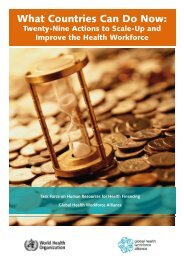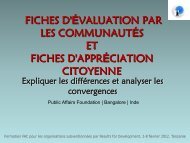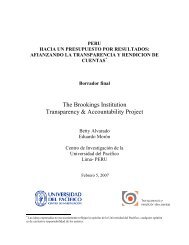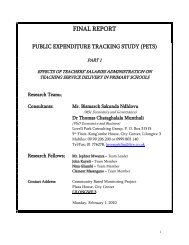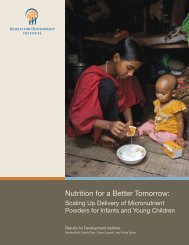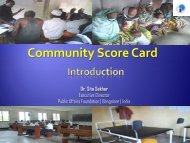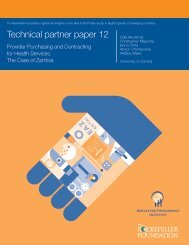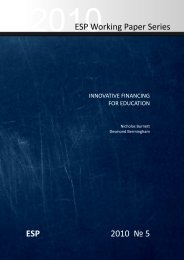Innovative Secondary Education For Skills Enhancement
Innovative Secondary Education For Skills Enhancement
Innovative Secondary Education For Skills Enhancement
Create successful ePaper yourself
Turn your PDF publications into a flip-book with our unique Google optimized e-Paper software.
Cost. NAMCOL currently receives a government grant<br />
that covers 65 percent of the mainstream per capita allocation.<br />
Students at NAMCOL are required to pay 20 percent<br />
of the course costs to cover books and other learning materials.<br />
Similarly, BOCODOL’s costs per learner are about<br />
one-fifth of the cost in conventional schools, although this<br />
does not take account of the cost of using conventional<br />
school facilities, which are often used in the evenings or<br />
school holidays for face-to-face tutoring sessions.<br />
Replication. As demonstrated by its replication in Botswana,<br />
the NAMCOL model is cost effective, replicable,<br />
and can be applied at scale. However, it takes investment<br />
and commitment from government to establish and support<br />
these open schooling institutions, both financially and<br />
from a policy perspective.<br />
Innovations Targeting<br />
Excluded Populations<br />
In addition to open schooling and distance learning<br />
programs designed to reach rural populations that are<br />
excluded from traditional schooling systems, innovative<br />
models in Africa exist to target other populations that may<br />
be excluded from traditional schooling due to economic or<br />
social factors. Those include particularly poor populations,<br />
many of whom are most likely destined for employment<br />
in the informal sector, and female populations who may<br />
not receive equal education opportunities due to lack of<br />
economic or familial support. In particular, entrants in the<br />
ISESE competition focused on the latter group, including<br />
the Africa region runner-up.<br />
Jua Kali (Kenya)<br />
The Jua Kali (“hot sun”) pilot voucher program was an<br />
initiative launched by the Kenyan government in 1994 to<br />
provide training to entrepreneurs in Kenya, under the larger<br />
Kenya Micro and Small Enterprise Training and Technology<br />
Project. The long-term goal of this project was to support<br />
skills development, and particularly to subsidize the cost of<br />
this training to those in the informal sector.<br />
Approach. Under the Jua Kali initiative, which targeted<br />
the informal sector and small businesses, vouchers were<br />
provided to micro- and small entrepreneurs, who could<br />
use them to obtain management or technical training. This<br />
demand-side financing mechanism was designed to both<br />
increase the productivity of small-scale workers and boost<br />
the supply of training providers. Importantly, women<br />
were specifically targeted in the initiative: although the<br />
voucher program required that entrepreneurs applying<br />
already have an established business, women were exempt<br />
from this rule. This exemption meant that about 57<br />
Even with increased training,<br />
entrepreneurs in many developing<br />
countries may still face financial and<br />
regulatory constraints to scaling<br />
up their enterprises, and market<br />
reforms need to go hand in hand<br />
with any financing mechanism.<br />
percent of the enterprises were women-run, in contrast to<br />
the initial target of only 20 percent (World Bank 2005).<br />
Impact. The World Bank project assessment report notes<br />
that over the six-year project period, about 35,000 enterprises<br />
received training (World Bank 2005). The six-year<br />
project ended in 2002, and although the pilot assessment<br />
noted that the program had a positive impact on productivity<br />
and earnings, the final report rated the project<br />
outcome “moderately unsatisfactory,” taking into account<br />
relevance, efficacy, and efficiency.<br />
Notably, institutional factors likely played a significant<br />
role in determining the growth of businesses, and this facet<br />
of the market needs to be appropriately addressed. Even<br />
with increased training, entrepreneurs in many developing<br />
countries may still face financial and regulatory constraints<br />
to scaling up their enterprises, and market reforms need to<br />
go hand in hand with any financing mechanism.<br />
Cost and Sustainability. The voucher component of<br />
the six-year project was estimated to be US$12 million,<br />
provided via the World Bank’s International Development<br />
Association credit facility (Adams 1997). Vouchers<br />
were given to those in the informal sector from allocation<br />
agencies in the country, with applicants required to pay 10<br />
percent of the voucher value. Unfortunately, while there<br />
was a positive impact on productivity and 80 percent of<br />
trainees were very positive about the quality of training<br />
received, the World Bank concedes that the program itself<br />
was not very cost effective or sustainable. The supply of<br />
training providers remained inelastic, and so providers<br />
were able to raise their prices in response to the increased<br />
demand (World Bank 2005). The Bank acknowledges that<br />
subsidies were a relatively higher-cost method of providing<br />
training, and that there may have been some level of<br />
oversubsidization.<br />
<strong>Innovative</strong> Models for <strong>Skills</strong> <strong>Enhancement</strong> in Africa and Asia 41



